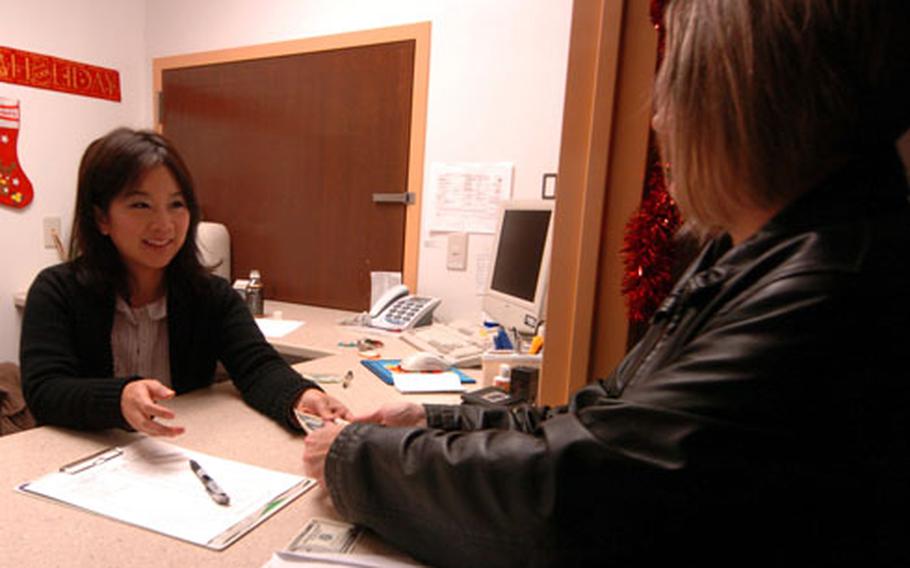
Yoko Maeda, left, assists as Jennifer Benefield exchanges dollars for yen Dec. 24 in the slot machine area of Chili’s Grill and Bar on Yokosuka Naval Base, Japan. (Photo by Tim Wightman/Stars and Stripes)
An airman converting a paycheck into euros bought bratwurst in Germany a bit cheaper for a while in 2008, while a sailor in Japan now pays 20 percent more for sushi than in January.
That isn’t because the Germans bred too many pigs or because the Japanese have forgotten how to fish.
Both situations were partially due to the unraveling of an investment process known as the "carry trade" and fueled further by market uncertainty.
For many years, investors have borrowed money from stable countries offering low interest rates and then invested that money in countries promising higher yields.
The U.S. Federal Reserve’s low rates made the dollar attractive to borrow during the past decade, but the yen was the global investor’s darling.
Japan’s largest banks have been offering loans at less than 2 percent interest since 1996, according to the Bank of Japan’s Web site.
All investors had to do was take their cheap yen and find an investment that would earn more than 2 percent after taxes, then reap the profits.
They did so in droves. Estimates vary wildly, but a Merrill Lynch analyst in 2007 estimated the yen carry trade alone at more than $1 trillion.
However, this strategy worked only if the currency that was borrowed remained weak enough in comparison to whatever it bought.
In 2008, U.S. stock markets lost more than 40 percent of their value, and global markets fared no better.
Cash-strapped investors sold their foreign investments, took their dollars back and stuffed them into safe havens, increasing dollar demand and pushing the currency higher.
The same thing happened with the heavily borrowed yen, so much so that even the dollar has tumbled against it. Broader economic forces and investor fear have exacerbated the trend.
Because of higher interest rates and its relatively recent introduction, the euro wasn’t a key player in the carry trade.
Takashi Matsumura, economist at Mizuho Research Institute in Tokyo, says that global investors who had poured yen and dollars into Europe have taken them back, leaving a less desirable — and therefore weaker — euro to languish in comparison.
Matsumura isn’t optimistic about the dollar’s chance of a quick rebound against the yen.
"We predict that the growth rate of the United States will begin to pick up in the latter part of next year and … that is when dollars will start rising again (against the yen)," he said.
However, servicemembers in Japan could see some short-term relief against the strong yen if the Japanese government can effectively intervene in the currency market.
As a whole, Japan doesn’t want its currency to be as strong as it is now. Its strength is pushing up prices on its exports and companies like Toyota are looking at their first potential losses ever because their cars now cost too much abroad.
That led Bank of Japan policy board member Hidetoshi Kamezaki to say at a press conference last week that the bank is considering "extraordinary steps" to make sure its flagging corporations have access to cash.
A greater supply of cash, in theory, should weaken the Japanese currency.
That will be a relief to servicemembers in Japan who say that despite their cost-of-living allowance, they did a lot more of their holiday shopping on base this year rather than at local stores.
"It’s really bad timing, with the exchange rates dropping too close to the holiday season," Petty Officer 2nd Class John Mason said at Yokosuka Naval Base. "We’re waiting on next month’s COLA to come up and keep pace with the changes."
Servicemembers also have to be careful about getting charged for insufficient funds when they pay their off-base Japanese bills and rent, said Petty Officer 2nd Class Alton Woodery, a sailor who lives outside Yokosuka Naval Base.
When they use a service like GI Bill Pay, they’ll have to keep more dollars in their account to cover the lower exchange rate.
Servicemembers making large payments in yen might consider Japanese bank rates alongside the military banking rate.
On Dec. 24, while Community Bank offered 87 yen to the dollar, Japanese banks in Tokyo and Okinawa offered 87.72 yen to the dollar.
Someone changing $10,000 to cover a hefty Japanese apartment security deposit and key money charge would net an extra 7,200 yen — about $80 — at the Japanese bank.
However, that small rate difference isn’t enough to keep many servicemembers, just like many Americans getting through the recession, from cutting back on spending they thought little of a year ago.
"I’d pull 30,000 yen out once a month on a weekend and go have fun, but I can’t do that anymore," Woodery said.
Stars and Stripes reporter Chiyomi Sumida contributed to this story.